Dynamic Identification Tests of 20th Century Historic Masonry Buildings in Japan
Abstract
:1. Introduction
2. Research Methodologies
2.1. Dynamic Identification Tests
2.2. Research Procedures
3. Case Study Description
3.1. Description of the Structures
3.1.1. Otaru Warehouse
3.1.2. Matsumoto Storehouse
3.2. Occurrence of Earthquakes during the Monitoring Period
4. Experimental Results
4.1. Vibration Testing
4.1.1. Otaru Warehouse
4.1.2. Matsumoto Warehouse
4.2. Monitoring
4.2.1. Otaru Warehouse
4.2.2. Matsumoto Storehouse
5. Numerical Simulation
5.1. Description of the Numerical Models
5.2. Eigenvalue Analysis
5.2.1. Otaru Warehouse
5.2.2. Matsumoto Storehouse
5.3. Nonlinear Static Analysis
5.3.1. Otaru Warehouse
5.3.2. Matsumoto Storehouse
6. Discussion
6.1. Usefulness of the Acquisition of Natural Frequencies under Different Conditions
6.2. Calibration of Numerical Models Based on Dynamic Identification Tests
7. Conclusions
Author Contributions
Funding
Institutional Review Board Statement
Informed Consent Statement
Data Availability Statement
Conflicts of Interest
References
- Migoń, P.; Pijet-Migoń, E. Natural disasters, geotourism, and geo-interpretation. Geoheritage 2019, 11, 629–640. [Google Scholar] [CrossRef] [Green Version]
- Ortiz, P.; Antunez, V.; Martín, J.M.; Ortiz, R.; Vázquez, M.A.; Galán, E. Approach to environmental risk analysis for the main monuments in a historical city. J. Cult. Herit. 2014, 15, 432–440. [Google Scholar] [CrossRef]
- Diaferio, M.; Foti, D.A. procedure for the seismic risk assessment of the cultural heritage. Bull. Earthq. Eng. 2021, 19, 1027–1050. [Google Scholar] [CrossRef]
- Brando, G.; De Matteis, G.; Spacone, E. Predictive model for the seismic vulnerability assessment of small historic centres: Application to the inner Abruzzi Region in Italy. Eng. Struct. 2017, 153, 81–96. [Google Scholar] [CrossRef]
- Ruggieri, S.; Tosto, C.; Rosati, G.; Uva, G.; Ferro, A. Seismic vulnerability analysis of Masonry Churches in Piemonte after 2003 Valle Scrivia earthquake: Post-event screening and situation 17 years later. Int. J. Archit. Herit. 2020, 1–29. [Google Scholar] [CrossRef]
- Leggieri, V.; Zagari, G.; Ruggieri, S.; Uva, G. Appraising seismic vulnerability of masonry aggregates through an automated mechanical typological approach. Autom. Constr. 2021, 132, 103972. [Google Scholar] [CrossRef]
- Guzmán, P.C.; Roders, A.R.P.; Colenbrander, B.J.F. Measuring links between cultural heritage management and sustainable urban development: An overview of global monitoring tools. Cities 2017, 60, 192–201. [Google Scholar] [CrossRef]
- Risbøl, O.; Briese, C.; Doneus, M.; Nesbakken, A. Monitoring cultural heritage by comparing DEMs derived from historical aerial photographs and airborne laser scanning. J. Cult. Herit. 2015, 16, 202–209. [Google Scholar] [CrossRef] [Green Version]
- Agapiou, A.; Lysandrou, V.; Alexakis, D.D.; Themistocleous, K.; Cuca, B.; Argyriou, A.; Sarris, A.; Hadjimitsis, D.G. Cultural heritage management and monitoring using remote sensing data and GIS: The case study of Paphos area, Cyprus. Comput. Environ. Urban. Syst. 2015, 54, 230–239. [Google Scholar] [CrossRef]
- Makoond, N.; Pelà, L.; Molins, C.; Roca, P.; Alarcón, D. Automated data analysis for static structural health monitoring of masonry heritage structures. Struct. Control. Health Monit. 2020, 27, e2581. [Google Scholar] [CrossRef]
- Votsis, R.A.; Kyriakides, N.; Chrysostomou, C.Z.; Tantele, E.; Demetriou, T. Ambient vibration testing of two masonry monuments in Cyprus. Soil Dyn. Earthq. Eng. 2012, 43, 58–68. [Google Scholar] [CrossRef]
- Diaferio, M.; Foti, D.; Potenza, F. Prediction of the fundamental frequencies and modal shapes of historic masonry towers by empirical equations based on experimental data. Eng. Struct. 2018, 156, 433–442. [Google Scholar] [CrossRef]
- Roselli, I.; Malena, M.; Mongelli, M.; Cavalagli, N.; Gioffrè, M.; De Canio, G.; de Felice, G. Health assessment and ambient vibration testing of the “Ponte delle Torri” of Spoleto during the 2016–2017 Central Italy seismic sequence. J. Civ. Struct. Health Monit. 2018, 8, 199–216. [Google Scholar] [CrossRef]
- Atamturktur, S.; Hemez, F.M.; Laman, J.A. Uncertainty quantification in model verification and validation as applied to large scale historic masonry monuments. Eng. Struct. 2012, 43, 221–234. [Google Scholar] [CrossRef]
- Dolce, M.; Nicoletti, M.; De Sortis, A.; Marchesini, S.; Spina, D.; Talanas, F. Osservatorio sismico delle strutture: The Italian structural seismic monitoring network. Bull. Earthq. Eng. 2017, 15, 621–641. [Google Scholar] [CrossRef] [Green Version]
- Ceroni, F.; Sica, S.; Pecce, M.R.; Garofano, A. Evaluation of the natural vibration frequencies of a historical masonry building accounting for SSI. Soil Dyn. Earthq. Eng. 2014, 64, 95–101. [Google Scholar] [CrossRef]
- Ramos, L.F.; Marques, L.; Lourenço, P.B.; De Roeck, G.; Campos-Costa, A.; Roque, J. Monitoring historical masonry structures with operational modal analysis: Two case studies. Mech. Syst. Signal Process. 2010, 24, 1291–1305. [Google Scholar] [CrossRef] [Green Version]
- Torres, W.; Almazán, J.L.; Sandoval, C.; Boroschek, R. Operational modal analysis and FE model updating of the Metropolitan Cathedral of Santiago, Chile. Eng. Struct. 2017, 143, 169–188. [Google Scholar] [CrossRef]
- Ihsan, E.B.; Dais, D.; Smyrou, E.; Sarhosis, V. Monitoring of a historical masonry structure in case of induced seismicity. Int. J. Archit. Herit. 2021, 15, 187–204. [Google Scholar]
- Aras, F.; Krstevska, L.; Altary, G.; Tashkov, L. Experimental and numerical modal analyses of a historical masonry palace. Constr. Build. Mater. 2011, 25, 81–91. [Google Scholar] [CrossRef]
- Drozg, A.; Rogelj, J.; Čepon, G.; Boltežar, M. On the performance of direct piezoelectric rotational accelerometers in experimental structural dynamics. Measurement 2018, 127, 292–298. [Google Scholar] [CrossRef]
- Azzara, R.M.; Girardi, M.; Iafolla, V.; Lucchesi, D.; Padovani, C.; Pellegrini, D. Ambient vibrations of age-old masonry towers: Results of long-term dynamic monitoring in the historic centre of Lucca. Int. J. Archit. Herit. 2021, 15, 5–21. [Google Scholar] [CrossRef] [Green Version]
- Gattulli, V.; Lepidi, M.; Potenza, F. Dynamic testing and health monitoring of historic and modern civil structures in Italy. Struct. Monit. Maint. 2016, 3, 71–90. [Google Scholar] [CrossRef]
- Carr, J.J. Sensors and Circuits: Sensors, Transducers, and Supporting Circuits for Electronic Instrumentation, Measurement, and Control; Prentice Hall: Hoboken, NJ, USA, 1993. [Google Scholar]
- Kumar, R.; Hossain, A. Experimental performance and study of low power strain gaugewireless sensor node for structure health monitoring. Wirel. Pers. Commun. 2018, 101, 1657–1669. [Google Scholar] [CrossRef]
- Bedon, C.; Bergamo, E.; Izzi, M.; Noè, S. Prototyping and Validation of MEMS Accelerometers for Structural Health Monitoring—The Case Study of the Pietratagliata Cable-Stayed Bridge. J. Sens. Actuator Netw. 2018, 7, 30. [Google Scholar] [CrossRef] [Green Version]
- Milne, D.; Pen, L.L.; Watson, G.; Thompson, D.; Powrie, W.; Hayward, M.; Morley, S. Proving MEMS technologies for smarter railway infrastructure. Procedia Eng. 2016, 143, 1077–1084. [Google Scholar] [CrossRef] [Green Version]
- Dumont, M.; Wolf, D. Usage of MEMS capacitive acceleration sensors for structural monitoring. Dyn. Civ. Struct. 2019, 2, 77–89. [Google Scholar]
- Sabato, A.; Niezrecki, C.; Fortino, G. Wireless MEMS-based accelerometer sensor boards for structural vibration monitoring: A review. IEEE Sens. J. 2016, 17, 226–235. [Google Scholar] [CrossRef]
- Lammel, G. The future of MEMS sensors in our connected world. In Proceedings of the 28th IEEE International Conference on Micro Electro Mechanical Systems (MEMS 2015), Estoril, Portugal, 18–22 January 2015. [Google Scholar]
- Norris, A.; Saafi, M.; Romine, P. Temperature and moisture monitoring in concrete structures using embedded nanotechnology/microelectromechanical systems (MEMS) sensors. Constr. Build. Mater. 2008, 22, 111–120. [Google Scholar] [CrossRef]
- Akyildiz, I.F.; Su, W.; Sankarasubramaniam, Y.; Cayirci, E. Wireless sensor networks: A survey. Comput. Netw. 2002, 38, 393–422. [Google Scholar] [CrossRef] [Green Version]
- Potenza, F.; Federici, F.; Lepidi, M.; Gattulli, V.; Graziosi, F.; Colarieti, A. Long-term structural monitoring of the damaged Basilica, S. Maria di Collemaggio through a low-cost wireless sensor network. J. Civil. Struct. Health Monit. 2015, 5, 655–676. [Google Scholar] [CrossRef]
- Cabboi, A.; Gentile, C.; Saisi, A. From continuous vibration monitoring to FEM-based damage assessment: Application on a stone-masonry tower. Constr. Build. Mater. 2017, 156, 252–265. [Google Scholar] [CrossRef]
- Ubertini, F.; Cavalagli, N.; Kita, A.; Comanducci, G. Assessment of a monumental masonry bell-tower after 2016 Central Italy seismic sequence by long-term SHM. Bull. Earthq. Eng. 2018, 16, 775–801. [Google Scholar] [CrossRef]
- Aloisio, A.; Alaggio, R.; Fragiacomo, M. Dynamic identification of a masonry façade from seismic response data based on an elementary ordinary least squares approach. Eng. Struct. 2019, 197, 109415. [Google Scholar] [CrossRef]
- Barsocchi, P.; Bartoli, G.; Betti, M.; Girardi, M.; Mammolito, S.; Pellegrini, D.; Zini, G. Wireless sensor networks for continuous structural health monitoring of historic masonry towers. Int. J. Archit. Herit. 2021, 15, 22–44. [Google Scholar] [CrossRef]
- Tronci, E.M.; De Angelis, M.; Betti, R.; Altomare, V. Vibration-based structural health monitoring of a RC-masonry tower equipped with non-conventional TMD. Eng. Struct. 2020, 224, 111212. [Google Scholar] [CrossRef]
- Ramos, L.F.; Lourenço, P.B. Modeling and vulnerability of historical city centers in seismic areas: A case study in Lisbon. Eng. Struct. 2004, 26, 1295–1310. [Google Scholar] [CrossRef] [Green Version]
- Lepidi, M.; Gattulli, V.; Foti, D. Swinging-bell resonances and their cancellation identified by dynamical testing in a modern bell tower. Eng. Struct. 2009, 31, 1486–1500. [Google Scholar] [CrossRef]
- Solarino, F.; Oliveira, D.V.; Giresini, L. Wall-to-horizontal diaphragm connections in historical buildings: A state-of-the-art review. Eng. Struct. 2019, 199, 109559. [Google Scholar] [CrossRef]
- Shabani, A.; Kioumarsi, M.; Zucconi, M. State of the art of simplified analytical methods for seismic vulnerability assessment of unreinforced masonry buildings. Eng. Struct. 2021, 239, 112280. [Google Scholar] [CrossRef]
- Aşıkoğlu, A.; Vasconcelos, G.; Lourenço, P.B.; Pantò, B. Pushover analysis of unreinforced irregular masonry buildings: Lessons from different modeling approaches. Eng. Struct. 2020, 218, 110830. [Google Scholar] [CrossRef]
- Maccarini, H.; Vasconcelos, G.; Rodrigues, H.; Ortega, J.; Lourenço, P.B. Out-of-plane behavior of stone masonry walls: Experimental and numerical analysis. Constr. Build. Mater. 2018, 179, 430–452. [Google Scholar] [CrossRef]
- Başaran, H.; Demir, A.; Ercan, E.; Nohutçu, H.; Hökelekli, E.; Kozanoğlu, C. Investigation of seismic safety of a masonry minaret using its dynamic characteristics. Earthq. Struct. 2016, 10, 523–538. [Google Scholar] [CrossRef]
- Clementi, F.; Pierdicca, A.; Formisano, A.; Catinari, F.; Lenci, S. Numerical model upgrading of a historical masonry building damaged during the 2016 Italian earthquakes: The case study of the Podestà palace in Montelupone (Italy). J. Civ. Struct. Health Monit. 2017, 7, 703–717. [Google Scholar] [CrossRef]
- de Silva, F.; Pitilakis, D.; Ceroni, F.; Sica, S.; Silvestri, F. Experimental and numerical dynamic identification of a historic masonry bell tower accounting for different types of interaction. Soil Dyn. Earthq. Eng. 2018, 109, 235–250. [Google Scholar] [CrossRef]
- Ercan, E. Assessing the impact of retrofitting on structural safety in historical buildings via ambient vibration tests. Constr. Build. Mater. 2018, 164, 337–349. [Google Scholar] [CrossRef]
- Tokyo Measuring Instruments Laboratory. Available online: https://tml.jp/e (accessed on 31 August 2021).
- Tokyo Sokushin. Available online: http://www.to-soku.co.jp/en/ (accessed on 31 August 2021).
- Netplus. Available online: https://netplus-3d.co.jp (accessed on 31 August 2021).
- Endo, Y.; Niitsu, Y. Health monitoring tests of heritage structures: Application of mems accelerometers to two multi-tier pagodas. In Proceedings of the 12th International Conference on Structural Analysis and Historical Constructions, Barcelona, Spain, 30 September–1 October 2021; pp. 3264–3271. [Google Scholar]
- Analog Devices. Available online: https://www.analog.com/media/en/technical-documentation/data-sheets/adxl354_adxl355.pdf (accessed on 31 August 2021).
- Japan National Trust. Otaru Canal and Masonry Storehouses; Houei Printing: Tokyo, Japan, 1979. [Google Scholar]
- Hokkaido Division. Architectural Institute of Japan. In Heritage buildings in Otaru; Otaru City Educational Committee: Hokkaido, Japan, 1994. [Google Scholar]
- Otaru City Council. Available online: https://www.city.otaru.lg.jp/ (accessed on 31 August 2021).
- Engel, H. Measure and Construction of the Japanese House; Tuttle Publishing: Clarendon, VT, USA, 1985. [Google Scholar]
- Nishi, K.; Hozumi, K. What Is Japanese Architecture? (Horton H Trans.); Kodansha International: Tokyo, Japan, 1985. [Google Scholar]
- Geospatial Information Authority of Japan. Available online: http://www.kunijiban.pwri.go.jp/viewer/ (accessed on 15 October 2021).
- Information Network of Earthquake Disaster Prevention Technologies. Available online: https://iisee.kenken.go.jp/net/seismic_design_code/japan/japan.htm (accessed on 15 October 2021).
- Japanese Agency for Cultural Affairs. 2021. Available online: https://kunishitei.bunka.go.jp/ (accessed on 31 August 2021).
- Tsuchimoto, T. Recommendation for Registered Tangible Cultural Properties, the 50th Infantry Regiment Storehouse (Shinshu University Medical Information Room); Shinshu University: Nagano, Japan, 2011. [Google Scholar]
- Japan Meteorological Agency. Available online: http://www.data.jma.go.jp/svd/eqdb/data/shindo/index.html (accessed on 31 August 2021).
- United States Geological Survey. Available online: https://earthquake.usgs.gov/earthquakes/eventpage/us7000dz5t/executive (accessed on 31 August 2021).
- Mapchart. Available online: https://mapchart.net/ (accessed on 31 August 2021).
- National Research Institute for Earth Science and Disaster Resilience (NIED). NIED K-NET, KiK-net, National Research Institute for Earth Science and Disaster Resilience. 2019. Available online: http://www.kyoshin.bosai.go.jp/kyoshin/docs/kyoshin_index.html (accessed on 31 August 2021). [CrossRef]
- Ferreira, D.; Manie, J. DIANA Documentation Release 10; DIANA FEA: Delft, The Netherlands, 2019. [Google Scholar]
- Xue, J.; Ren, G.; Qi, L.; Zhang, X. Lateral behavior of glued-laminated timber frame infilled with light-wooden-frame wall hybrid system: Experimental and numerical analysis. Structures 2021, 30, 352–367. [Google Scholar] [CrossRef]
- Chang, W.S.; Shanks, J.; Kitamori, A.; Komatsu, K. The structural behaviour of timber joints subjected to bi-axial bending. Earthq. Eng. Struct. Dyn. 2009, 38, 739–757. [Google Scholar] [CrossRef]
- Kłosowski, P.; Pestka, A.; Krajewski, M.; Lubowiecka, I. Experimental and computational study on mechanical behaviour of carpentry corner log joints. Eng. Struct. 2020, 213, 110515. [Google Scholar] [CrossRef]
- Tsai, P.H.; D′Ayala, D. Performance-based seismic assessment method for Taiwanese historic Dieh-Dou timber structures. Earthq. Eng. Struct. Dyn. 2011, 40, 709–729. [Google Scholar] [CrossRef]
- Eurocode 6—Design of Masonry Structures. General Rules for Reinforced and Unreinforced Masonry Structures. EN 1996–1–1; European Committee for Standardization: Brussel, Belgium, 2005. [Google Scholar]
- BSI Standards Publication. Specification for Masonry Units. EN 771; European Committee for Standardization: Brussel, Belgium, 2011. [Google Scholar]
- BSI Standards Publication. Specification for Masonry Units—Part 2: Calcium Silicate Masonry Units EN 771-2; European Committee for Standardization: Brussel, Belgium, 2011. [Google Scholar]
- BSI Standards Publication. Specification for Masonry Units—Part 3: Aggregate Concrete Masonry Units (Dense and Light-Weight Aggregates) EN 771-3; European Committee for Standardization: Brussel, Belgium, 2003. [Google Scholar]
- Slovenian Institute for Standardization. Methods of Testing Cement—Part. 1: Determination of Strength EN 196-1; European Committee for Standardization: Brussel, Belgium, 2016. [Google Scholar]
- Lakshani, M.M.T.; Jayathilaka, T.K.G.A.; Thamboo, J.A. Experimental investigation of the unconfined compressive strength characteristics of masonry mortars. J. Build. Eng. 2020, 32, 101558. [Google Scholar] [CrossRef]
- Guadagnuolo, M.; Aurilio, M.; Basile, A.; Faella, G. Modulus of Elasticity and Compressive Strength of Tuff Masonry: Results of a Wide Set of Flat-Jack Tests. Buildings 2020, 10, 84. [Google Scholar] [CrossRef]
- Selçuk, L.; Beyaz, T. Welding intensity assessment of pyroclastic units based on engineering quality requirements. Arab. J. Geosci. 2021, 14, 382. [Google Scholar] [CrossRef]
- Nakamura, D.; Goto, T.; Suzuki, T.; Ito, Y.; Yamashita, S. Basic Study on Frost Susceptibility of Rock Understanding the mechanism of frost heave based on comparison of the internal structure and the physical properties of rock. Min. Mater. Process. Inst. Jpn. 2008, 124, 231–239. [Google Scholar]
- Nishina, K.; Matsuda, Y.; Matsueda, H.; Takeuchi, K.; Ohgane, T.; Sugawara, Y.; Takami, M.; Kitajima, T. Geology of subaqueous volcanic rocks and stone material of historic buildings, in Otaru, Hokkaido. J. Geol. Soc. Jpn. 2019, 125, 387–402. [Google Scholar] [CrossRef] [Green Version]
- Kodama, J.I.; Goto, T.; Fujii, Y.; Yoshida, Y.; Itakura, K.I. Creep deformation and creep life of Noboribetsu welded tuff under air-dried and water-saturated conditions. J. Min. Mater. Process. Inst. Jpn. 2001, 117, 718–724. [Google Scholar]
- Moayedian, S.M.; Hejazi, M. Stress-strain relationships for scaled gypsum mortar and cement mortar brick masonry. J. Build. Eng. 2021, 33, 101861. [Google Scholar] [CrossRef]
- Garzón-Roca, J.; Marco, C.O.; Adam, J.M. Compressive strength of masonry made of clay bricks and cement mortar: Estimation based on Neural Networks and Fuzzy Logic. Eng. Struct. 2013, 48, 21–27. [Google Scholar] [CrossRef]
- Zahra, T.; Thamboo, J.; Asad, M. Compressive strength and deformation characteristics of concrete block masonry made with different mortars, blocks and mortar beddings types. J. Build. Eng. 2021, 38, 102213. [Google Scholar] [CrossRef]
- Haach, V.G.; Vasconcelos, G.; Lourenço, P.B. Experimental analysis of reinforced concrete block masonry walls subjected to in-plane cyclic loading. J. Struct. Eng. 2010, 136, 452–462. [Google Scholar] [CrossRef]
- Mohamad, G.; Lourenço, P.B.; Roman, H.R. Mechanics of hollow concrete block masonry prisms under compression: Review and prospects. Cem. Concr. Compos. 2007, 29, 181–192. [Google Scholar] [CrossRef] [Green Version]
- Architectural Institute of Japan. Standard for Structural Design of Timber Structures; Maruzen Publishing: Tokyo, Japan, 2006. [Google Scholar]
- Howard, S. Materials Data Book, 2003rd ed.; Cambridge University: Cambridge, UK, 2003. [Google Scholar]
- Vecchio, F.J.; Collins, M.P. The modified compression-field theory for reinforced concrete elements subjected to shear. ACI J. 1986, 83, 219–231. [Google Scholar]
- Selby, R.G.; Vecchio, F.J. A constitutive model for analysis of reinforced concrete solids. Can. J. Civil Eng. 1997, 24, 460–470. [Google Scholar] [CrossRef]
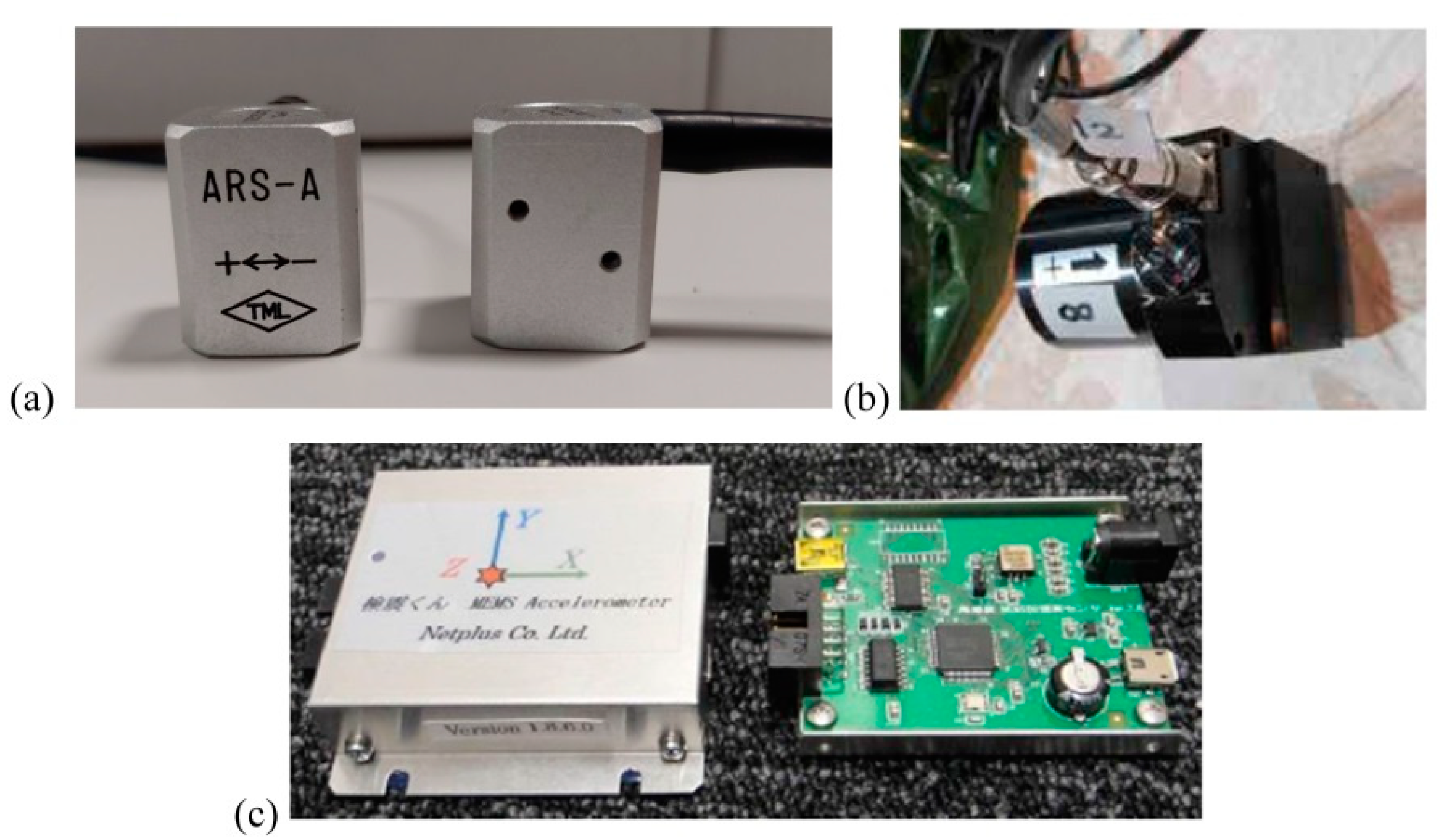
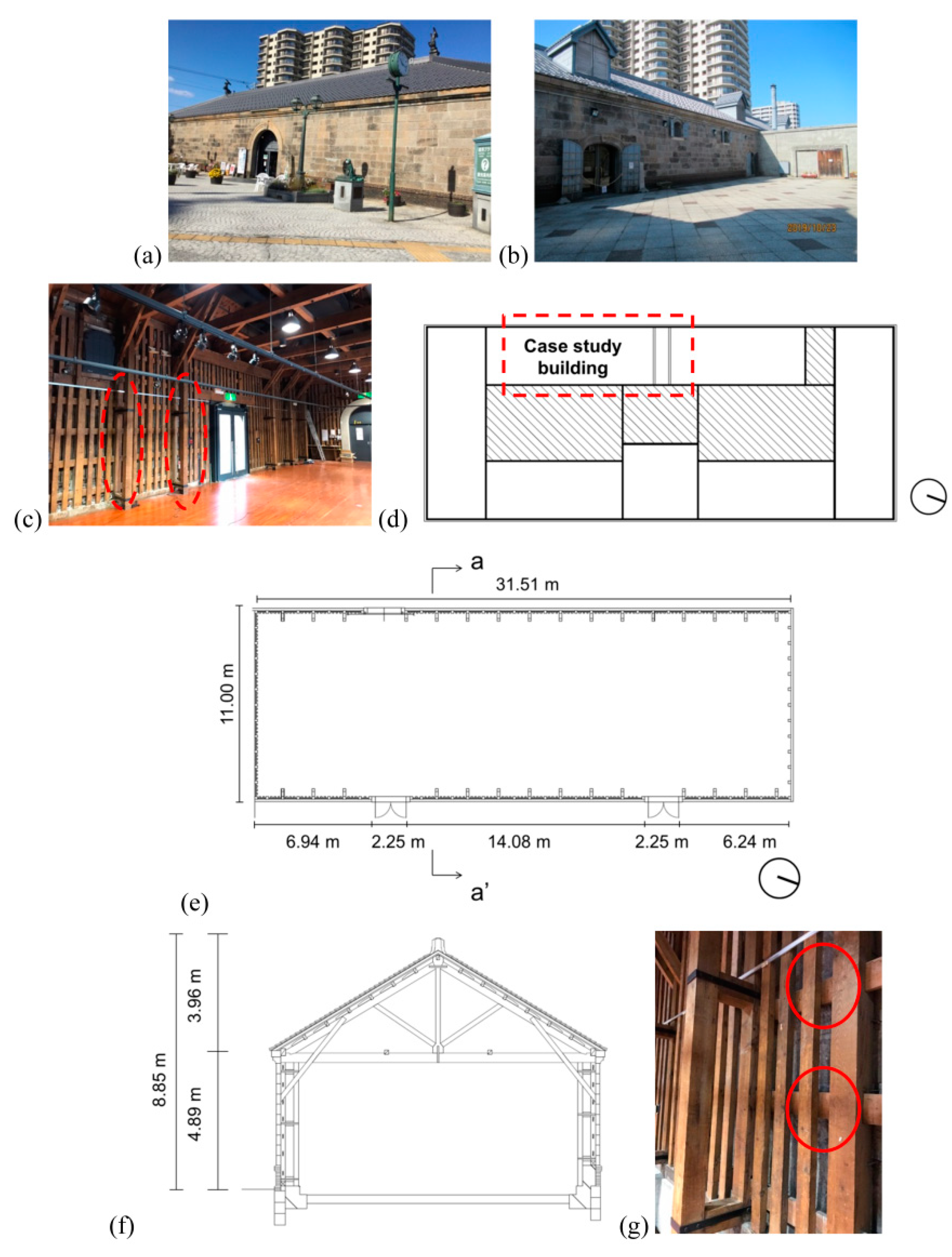
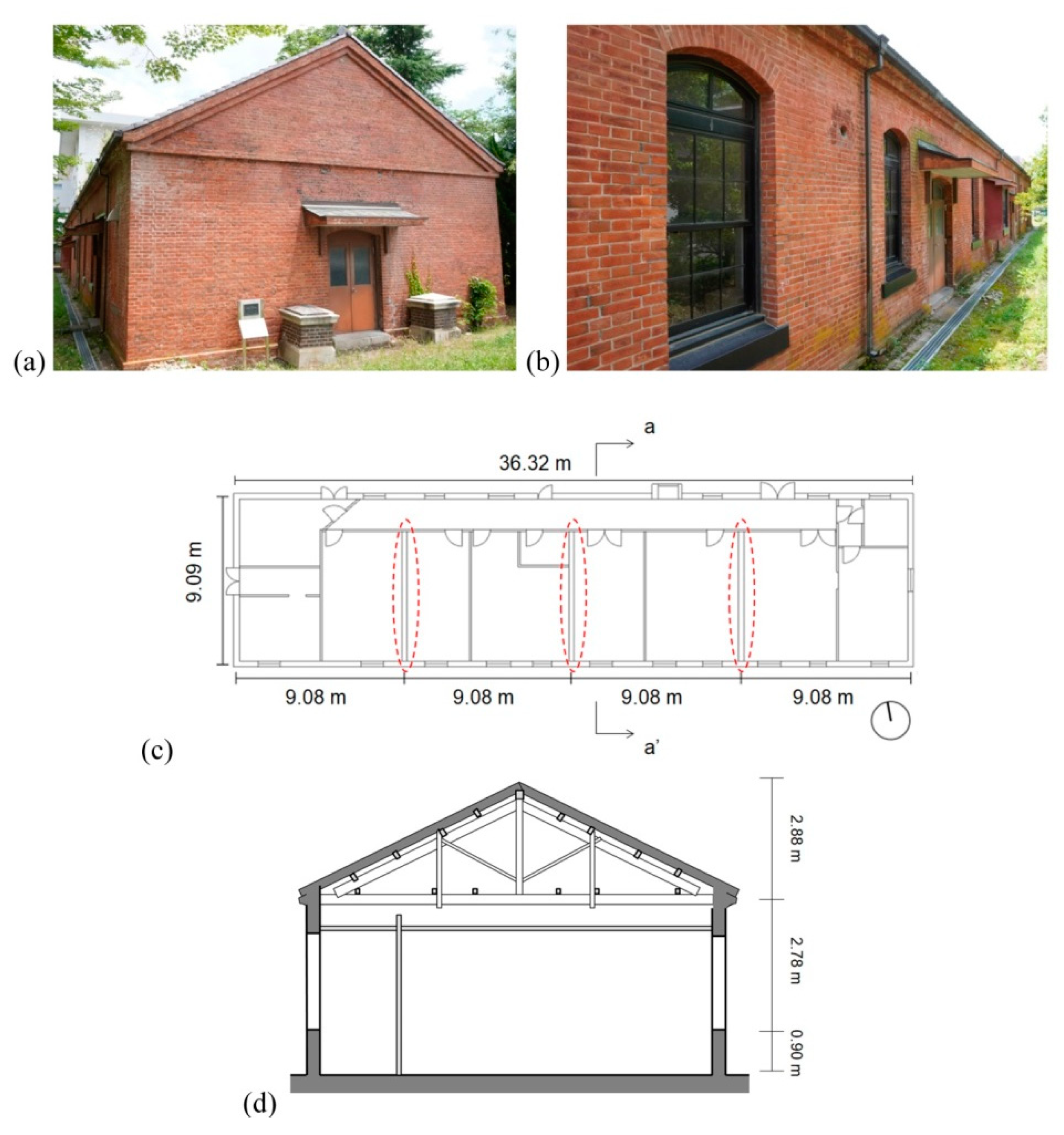

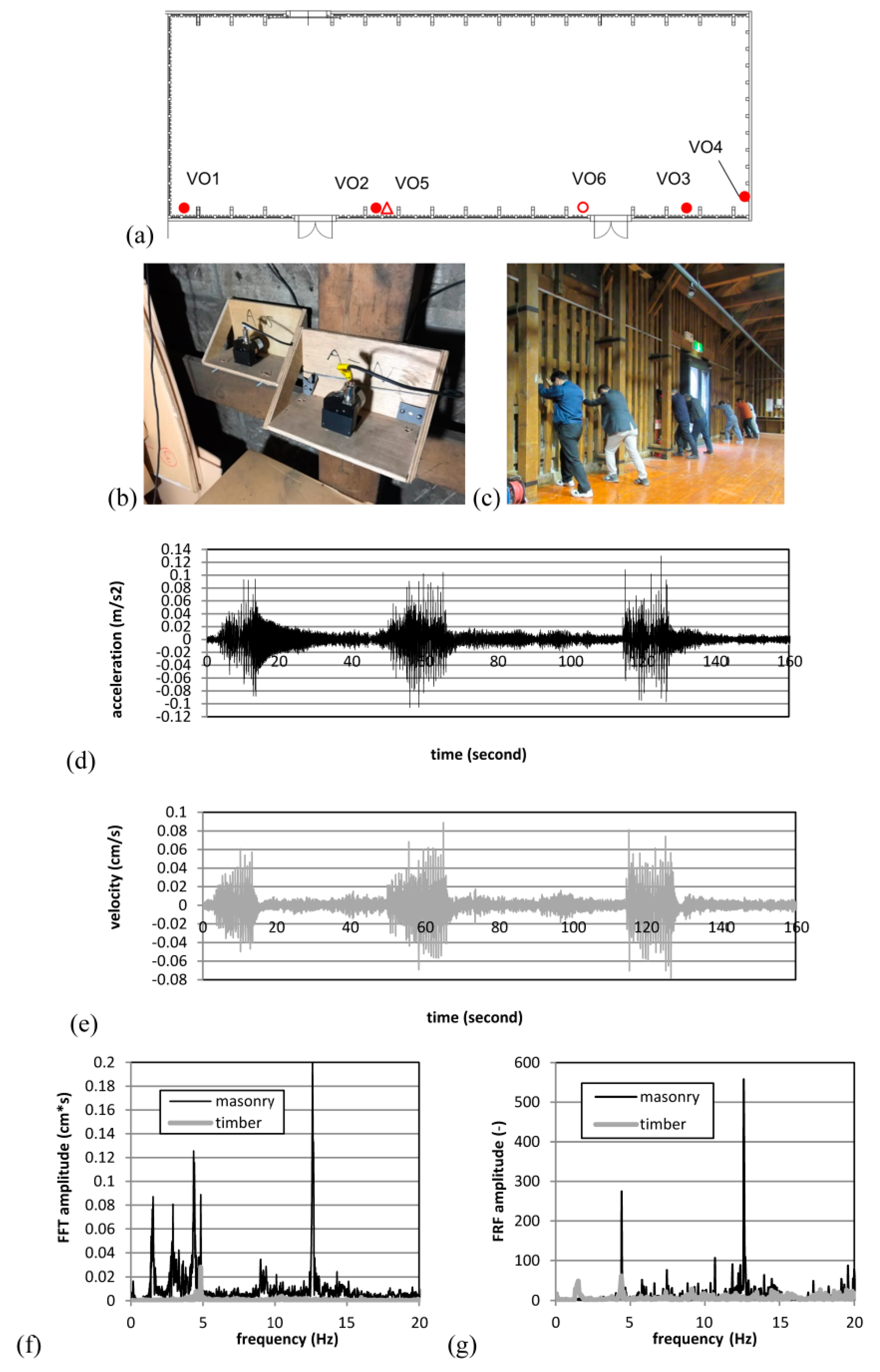
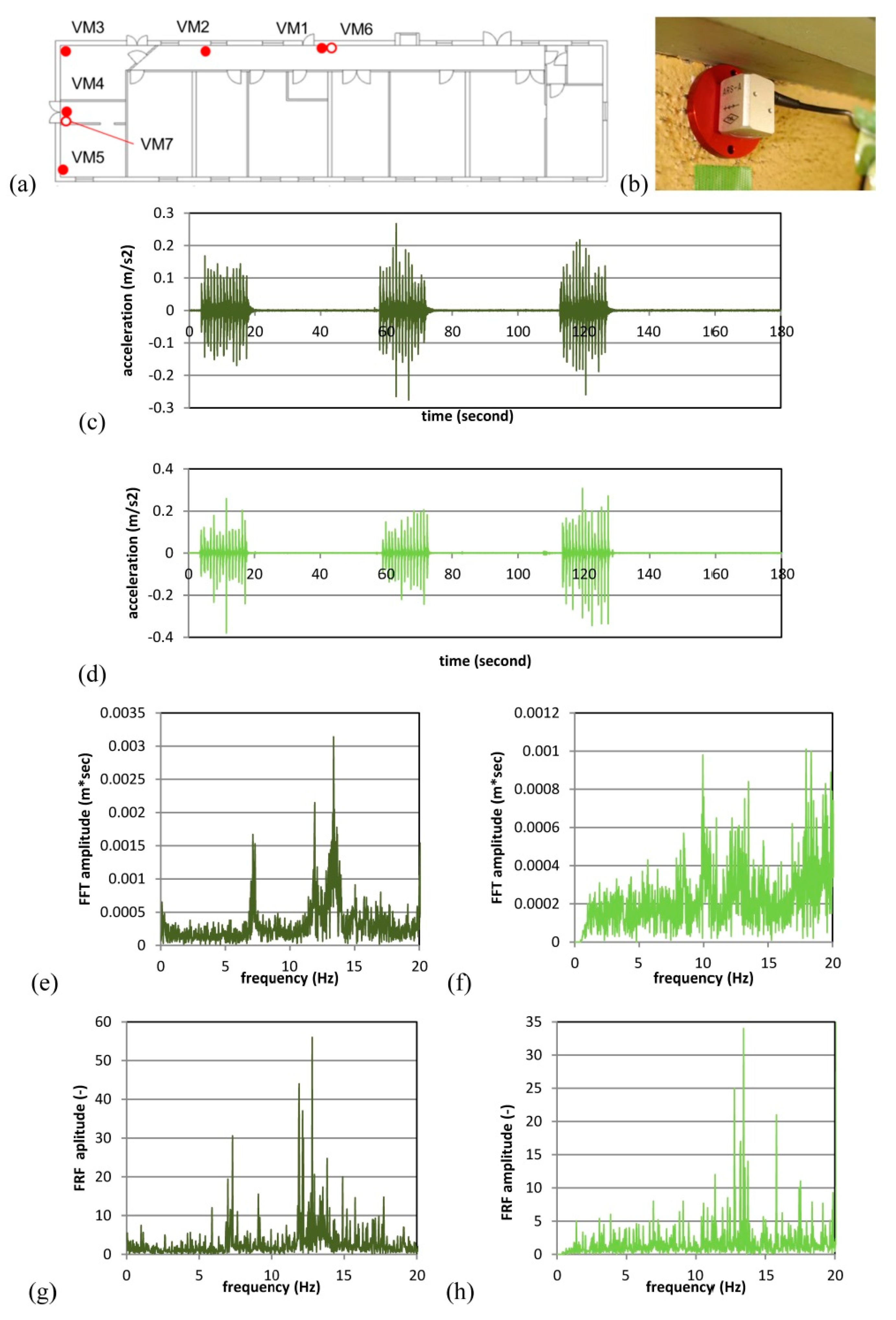
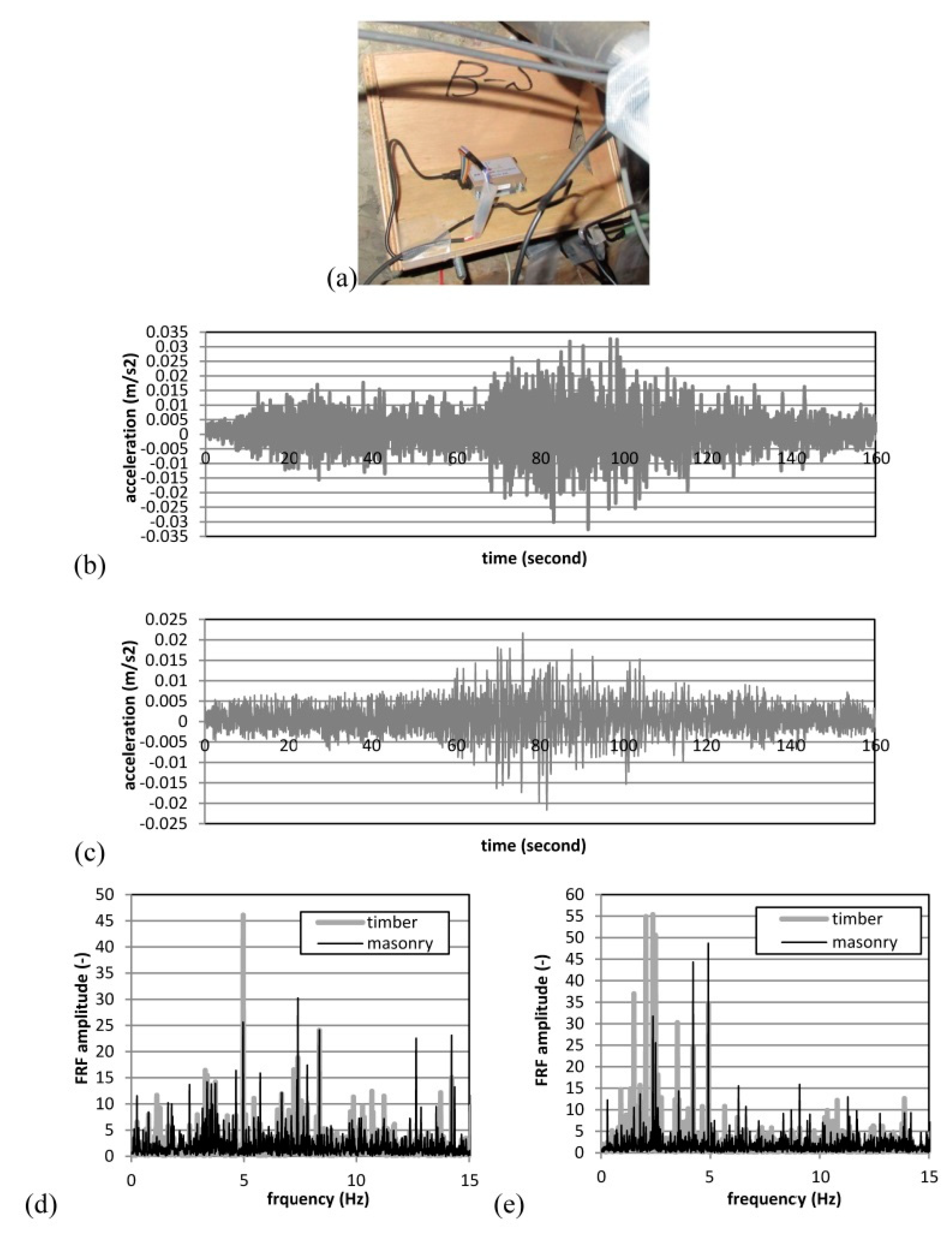






| Specifications | Strain-Gauge Aceerometers | Servo Velocity Meters | MEMS Sensors |
|---|---|---|---|
| Frequency range | 0 to 30 Hz | 0.2 to 70 Hz | 0 to 30 Hz |
| Resolution level | 0.0333 cm/s2 | 10−5 cm/s2 | 0.005 cm/s2 |
| Measuring range | ±10 m/s2 | ±0.1 m/s | ±20 m/s2 |
| Parameters | Brick Masonry | Concrete Block Masonry | Welded Tuff Masonry | Timber |
|---|---|---|---|---|
| Density (kg/m3) | 1800 | 2200 | 1300 | 430 |
| Compressive strength (MPa) | 10 | 10 | 5 | 20 |
| Modulus of elasticity (MPa) | 7000 | 7000 | 5000 | 7000 |
| Tensile strength (MPa) | 0.2 | 0.5 | 0.2 | 20 |
| Poisson ratio (-) | 0.2 | 0.2 | 0.2 | 0.3 |
| Eigenvalue Comparison | 1st Mode |
|---|---|
| Real structure (Hz) | 4.78 |
| Numerical model (Hz) | 4.78 |
| Participation factors (%) | 33.2 |
| Modal assurance criterion (-) | 0.97 |
| Eigenvalue Comparison | x-direction | y-direction |
|---|---|---|
| Real structure (Hz) | 13.4 | 12.2 |
| Numerical model (Hz) | 13.2 | 12.7 |
| Participation factors (%) | 2.9 | 7.53 |
| Modal assurance criterion (-) | 0.92 | 0.92 |
Publisher’s Note: MDPI stays neutral with regard to jurisdictional claims in published maps and institutional affiliations. |
© 2021 by the authors. Licensee MDPI, Basel, Switzerland. This article is an open access article distributed under the terms and conditions of the Creative Commons Attribution (CC BY) license (https://creativecommons.org/licenses/by/4.0/).
Share and Cite
Endo, Y.; Waki, Y.; Niitsu, Y.; Hanazato, T. Dynamic Identification Tests of 20th Century Historic Masonry Buildings in Japan. GeoHazards 2021, 2, 332-351. https://doi.org/10.3390/geohazards2040018
Endo Y, Waki Y, Niitsu Y, Hanazato T. Dynamic Identification Tests of 20th Century Historic Masonry Buildings in Japan. GeoHazards. 2021; 2(4):332-351. https://doi.org/10.3390/geohazards2040018
Chicago/Turabian StyleEndo, Yohei, Yuta Waki, Yasushi Niitsu, and Toshikazu Hanazato. 2021. "Dynamic Identification Tests of 20th Century Historic Masonry Buildings in Japan" GeoHazards 2, no. 4: 332-351. https://doi.org/10.3390/geohazards2040018
APA StyleEndo, Y., Waki, Y., Niitsu, Y., & Hanazato, T. (2021). Dynamic Identification Tests of 20th Century Historic Masonry Buildings in Japan. GeoHazards, 2(4), 332-351. https://doi.org/10.3390/geohazards2040018







